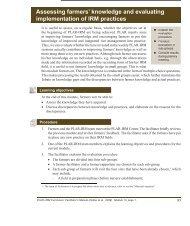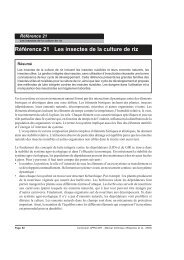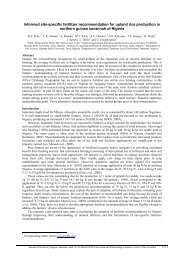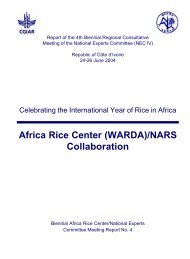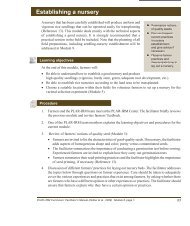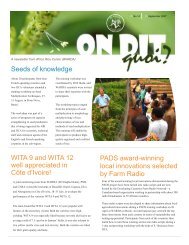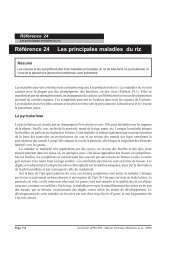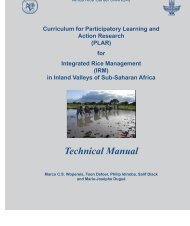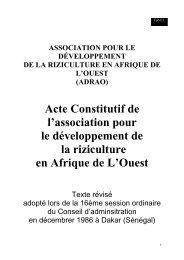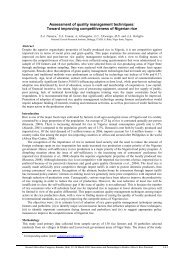- Page 1 and 2: Africa Rice Center (WARDA)®NERICA
- Page 3 and 4: Africa Rice Center (WARDA)®NERICA
- Page 5 and 6: PREFACEThis publication builds on t
- Page 7 and 8: PrefaceForewordTABLE OF CONTENTSiii
- Page 9 and 10: Module 13 - NERICA ® GRAIN AND NUT
- Page 12 and 13: LIST OF TABLESTable 1. Rice product
- Page 14 and 15: Module 1Overview: Rice in AfricaOVE
- Page 16 and 17: Module 1Overview: Rice in Africadue
- Page 18 and 19: Module 1Overview: Rice in Africaeno
- Page 22 and 23: Module 1Overview: Rice in AfricaUni
- Page 24 and 25: Module 2NERICA: origin, nomenclatur
- Page 26 and 27: Module 2NERICA: origin, nomenclatur
- Page 28 and 29: Module 2NERICA: origin, nomenclatur
- Page 30 and 31: Ratooning performance of NERICA var
- Page 32 and 33: Module 2NERICA: origin, nomenclatur
- Page 34 and 35: Module 2NERICA: origin, nomenclatur
- Page 36 and 37: Module 2NERICA: origin, nomenclatur
- Page 38 and 39: Module 2NERICA: origin, nomenclatur
- Page 40 and 41: Module 2NERICA: origin, nomenclatur
- Page 42 and 43: Module 2NERICA: origin, nomenclatur
- Page 44 and 45: Module 3NERICA dissemination insub-
- Page 46 and 47: Module 3NERICA dissemination insub-
- Page 48 and 49: Module 3NERICA dissemination insub-
- Page 50 and 51: Module 3NERICA dissemination insub-
- Page 52 and 53: Module 3NERICA dissemination insub-
- Page 54 and 55: Module 3NERICA dissemination insub-
- Page 56 and 57: Module 3NERICA dissemination insub-
- Page 58 and 59: Module 3NERICA dissemination insub-
- Page 60 and 61: Module 3NERICA dissemination insub-
- Page 62: Module 4Molecular characterisation
- Page 65 and 66: Module 4Molecular characterisation
- Page 67 and 68: Module 4Molecular characterisation
- Page 69 and 70: Module 4Molecular characterisation
- Page 71 and 72:
Module 4Molecular characterisation
- Page 73 and 74:
Module 4Molecular characterisation
- Page 75 and 76:
Module 5Drought screening of upland
- Page 77 and 78:
Module 5Drought screening of upland
- Page 79 and 80:
Module 6NERICA rice crop management
- Page 81 and 82:
Module 6NERICA rice crop management
- Page 83 and 84:
Module 6NERICA rice crop management
- Page 85 and 86:
Module 6NERICA rice crop management
- Page 87 and 88:
Module 6NERICA rice crop management
- Page 89 and 90:
Module 7Soil fertility and NERICA r
- Page 91 and 92:
Module 7Soil fertility and NERICA r
- Page 93 and 94:
Module 7Soil fertility and NERICA r
- Page 95 and 96:
Module 7Soil fertility and NERICA r
- Page 97 and 98:
Module 8Integrated Pest Management(
- Page 99 and 100:
Module 8Integrated Pest Management(
- Page 101 and 102:
Module 8Integrated Pest Management(
- Page 103 and 104:
Module 8Integrated Pest Management(
- Page 105 and 106:
Module 8Integrated Pest Management(
- Page 107 and 108:
Module 8Integrated Pest Management(
- Page 109 and 110:
Module 9Major rice diseases and con
- Page 111 and 112:
Module 10Improving seed delivery in
- Page 113 and 114:
Module 10Improving seed delivery in
- Page 115 and 116:
Module 10Improving seed delivery in
- Page 117 and 118:
Module 10Improving seed delivery in
- Page 119 and 120:
Module 11Improving NERICA seedavail
- Page 121 and 122:
Module 11Improving NERICA seedavail
- Page 123 and 124:
Module 11Improving NERICA seedavail
- Page 125 and 126:
Module 12Harvest and post-harvestop
- Page 127 and 128:
Module 12Harvest and post-harvestop
- Page 129 and 130:
Module 13Grain and nutritional qual
- Page 131 and 132:
Module 13Grain and nutritional qual
- Page 133 and 134:
Module 13Grain and nutritional qual
- Page 135 and 136:
Module 14NERICA impact and adoption
- Page 137 and 138:
Module 14NERICA impact and adoption
- Page 139 and 140:
Module 14NERICA impact and adoption
- Page 141 and 142:
Module 15Policies and institutions
- Page 143 and 144:
Module 15Policies and institutions
- Page 145 and 146:
Module 15Policies and institutions
- Page 147 and 148:
Module 15Policies and institutions
- Page 149 and 150:
Module 16NERICA rice and the United
- Page 151 and 152:
Module 17NERICA food preparation: f
- Page 153 and 154:
Module 17NERICA food preparation: f
- Page 155 and 156:
Module 17NERICA food preparation: f
- Page 157 and 158:
ReferencesBalasubramanian V, Siéop
- Page 159 and 160:
ReferencesPromotion of Rice Product
- Page 161 and 162:
References on equipment develop
- Page 163 and 164:
References 2000. Mapping and geno
- Page 165 and 166:
ReferencesErenstein.ecological grad
- Page 167 and 168:
ReferencesKebbeh M, MiézanPerforma
- Page 169 and 170:
ReferencesOgunbayo SA, , Guei RG, S
- Page 171 and 172:
ReferencesThe Developing Economies
- Page 173 and 174:
References, Sorho F, Pinel A, , , M
- Page 175 and 176:
AnnexesNERICA Passport Data3.3 Grai
- Page 177 and 178:
AnnexesNERICA Passport Data3.3 Grai
- Page 179 and 180:
AnnexesNERICA Passport Data3.3 Grai
- Page 181 and 182:
AnnexesNERICA Passport Data3.3 Grai
- Page 183 and 184:
AnnexesNERICA Passport Data3.3 Grai
- Page 185 and 186:
AnnexesNERICA Passport Data3.3 Grai
- Page 187 and 188:
AnnexesNERICA Passport Data3.3 Grai
- Page 189 and 190:
AnnexesNERICA Passport Data3.3 Grai
- Page 191 and 192:
AnnexesNERICA Passport Data3.3 Grai
- Page 193 and 194:
AnnexesNERICA Passport Data3.3 Grai
- Page 195 and 196:
AnnexesNERICA Passport Data3.3 Grai
- Page 197 and 198:
AnnexesNERICA Passport Data3.3 Grai
- Page 199 and 200:
AnnexesNERICA Passport Data3.3 Grai
- Page 201 and 202:
AnnexesNERICA Passport Data3.3 Grai
- Page 203 and 204:
AnnexesNERICA Passport Data3.2 Pani
- Page 205 and 206:
AnnexesNERICA Passport Data3.3 Grai
- Page 207 and 208:
AnnexesNERICA Passport Data3.3 Grai
- Page 209 and 210:
About the Consultative Group on Int



